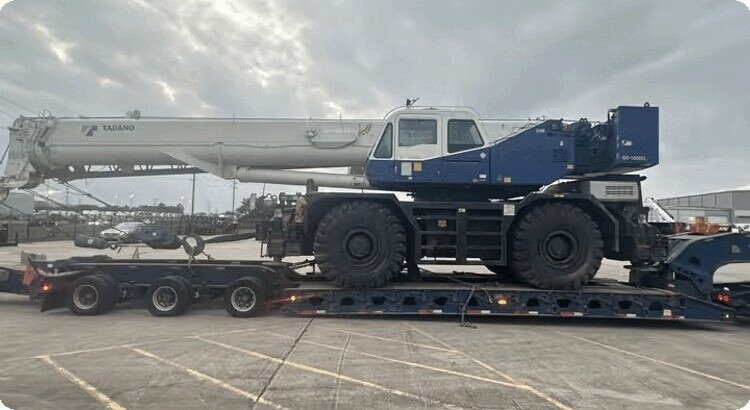The use of rough terrain cranes has remained one of the most preferred options among contractors in remote locations or rough terrains despite the presence of numerous specialized lifting machines in the current market. These work sites will not only need lifting power they will need equipment that can be brought in, erected and worked in locations that are not level or paved. Be it a pipeline in the middle of the field or a construction site with the dirt roads all around, rough terrain crane continues delivering. Its practical design and reliability under tough conditions explain why it’s still in heavy rotation on off-road projects.
Built for Unpredictable Terrain and Limited Access
The characteristic capability that defines rough terrain cranes is their stability on unstable ground and their ability to access challenging job sites. These machines feature large, deep-tread tires, high ground clearance, and 4-wheel drive, allowing them to move confidently through mud, gravel, uneven slopes, and loose surfaces where other cranes would struggle or be restricted entirely. Their compact design also lets them maneuver through tight passages and operate in confined areas. For those searching for rough terrain cranes for sale, this kind of versatility is essential, especially when site conditions can shift dramatically from day to day.
Quick Setup and Breakdown on Remote Job Sites
In most off-road situations time is as important as ability. The rough terrain cranes are set up rapidly and the outriggers are fully hydraulic and can be deployed without any problem and the self-levelling mechanisms cut down the manual adjustments. This implies that crews will be able to start lifting operations quicker without having to excessively prepare the site. These cranes also pack up as efficiently as they do the job, and they are ready to transfer to another job or site. This level of efficiency is worthwhile working in a far flung place where there are minimal resources and manpower.
Strong Lift Capacity in Compact, Mobile Frames
Rough terrain cranes are compact cranes that have used the relatively small size to fit in surprising lifting power. They are designed to carry heavy loads and yet they are light enough and can work in areas that are hard to manoeuvre. That is an important combination on off-road locations, where sometimes space is tight, yet heavy lifting is still necessary. The boom reach and load tables on most of them go a long way in ensuring that they are in a good position to handle lifts that previously would have necessitated use of bigger and less movable machines. Their capability of balancing between higher power of lifting and maneuverability gives them a significant advantage.
Maneuverability That Larger Cranes Can’t Match
Work place rarely provides ample open space, particularly in distant regions. The rough terrain cranes are built to navigate around the obstacles without any problem. These machines are capable of making narrow turns, and they can easily situate themselves on an area that a large crane cannot reach by utilizing such features as 4-wheel steering and crab steering modes. This is even more useful when the sites are crowded or are in natural terrain which cannot be re-graded or cleared. Their maneuverability isn’t just about convenience but it allows safe, accurate operation in places where flexibility is everything.
Lower Transport Costs Compared to Larger Cranes
Although rough terrain cranes are not road-legal and must be towed to the site, they’re still simpler and more cost-effective to relocate than many other types of heavy cranes. Their compact design, lighter weight, and lack of complex counterweight systems reduce transport costs and often lower permit requirements. This makes them especially attractive in the heavy equipment rental market, where contractors with multiple job sites value quick mobilization. The ability to move equipment efficiently can lead to significant savings especially when mobilization is a recurring cost across different project phases.
Reliability and Ease of Maintenance in Harsh Conditions
Cranes that are rough are constructed keeping durability in mind. They have been made less vulnerable to the fragile systems that may give way under pressure and most of them are built in such a way that they are easy to service in the field. That is important working hours to the closest maintenance yard. The tough construction aids in mitigating wear and tear and the service points are also easy to reach such that in case of repair, it can be quickly done on-site. Such dependability is not only convenient: it is also necessary in areas where failure can lead to lost deadlines and additional costs.
The Rough Terrain Crane’s Role in Modern Fleet Strategy
Rough terrain cranes continue to be a workhorse to construction firms, energy contractors and heavy equipment fleets. Their capacity to do well in both lifts and off-road capability places them in a special niche in the crane family. Although there are new types of technologies and more specialized cranes, not many can compare with all around capabilities of a well maintained rough terrain crane. They are simple to launch, affordable to use and can be able to adjust to the job-site conditions that vary on various projects. They are the reliable option to remote lifting applications among many others.
Related Reads
- Why Brisbane Locals Trust Metalbiz for Scrap Metal Sales
- Warehouse Company Dubai – Unlocking Efficient Storage Solutions with Shepherd International Logistics
- The North Face T Shirt: Outdoor Fashion with Everyday Appeal
- FUE Hair Transplant: The Most Authentic Remedy for Hair Loss
- Engineering Masterbatch: Masterbatch Manufacturers Driving High-Performance Plastics



